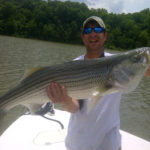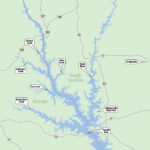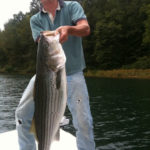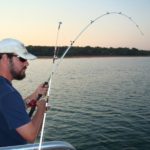
The striper fishery at Lake Russell is being managed for trophy fish — its history says it’s the right thing.
About 13 years ago, Rich King caught his first striped bass.
About eight years ago, he caught his first striped bass at Lake Russell.
Both moments changed him.
“I grew up in Anderson, fishing farm ponds for bass,” King said. “The first time I caught a striper I was with a buddy on Hartwell, and that was all it took.”
Several years later, when he ventured to nearby Lake Russell — a largely undeveloped reservoir snuggled between bigger and more-popular Hartwell and Thurmond along the Savannah River — King became truly smitten.
He found himself enthralled by everything that landing a large striped bass entailed: the clicking of a reel in full-scream mode, the thrill of battling a 40-pound fish on line designed to land one half that size, and of course, the accompanying adrenaline rush.
“I like the fight,” King said. “It’s like buck fever. It’s the same rush of adrenaline. I liked the idea of battling a saltwater fish in fresh water.”
But it didn’t happen overnight. After hearing tales of big striped bass at Russell, King simply “went and tried to find them,” he recalls.
It took a while.
“I went several times before I finally caught one,” King said.
When he finally did hook up, it was a good one — a fish in the 20-pound range that certainly qualified as enough of a line-stretcher to keep him coming back for more.
So he did.
There have been many memorable days, but King will never forget his best day at Russell, when he reeled in six stripers ranging in size from 28 to 44 pounds.
“It was ridiculous,” he admits.
King has never kept any of the massive stripers he’s hauled in, but he may reconsider some day. If he’s fortunate enough to drag a fish weighing 50 pounds or better over the side of his boat, it may accompany him on the trip home.
“I still have not caught a 50-pounder, but when I do, that’ll probably be the one I’ll keep,” he said.
King has come close — perhaps painfully close, on multiple occasions.
A couple of the hook-ups he’d rather not discuss in detail. All he knows is that he had visual contact with at least two fish that would push 60, perhaps even 70, pounds.
“It was so freakish that you’re like, ‘That didn’t just happen, did it?’ ” King said. “I’ve seen them roll, and then they’re gone. They just decide to run….”
And there wasn’t much that King was able to do except take a deep breath, console himself momentarily, tie on another bait and continue to fish.
“I fully believe the next world record will come out of Lake Russell,” King said. “I know that’s a bold statement, but I think it’s in there.”
That is indeed a bold statement, considering that the world-record striped bass, caught in Alabama just last February, weighed in at 69 pounds, 9 ounces.
Yet King’s contention may not be so far-fetched. Lake Russell has produced two of the most recent state-record catches in South Carolina, including the current best of 63 pounds.
Ironically, Lake Russell’s striped bass fishery was created not through great foresight or ambitious stocking programs and intensive management, but rather quite by accident.
“It just kind of developed on its own, with fish that either washed down through Hartwell or were pumped back through the Russell Dam,” said Dan Rankin, Upstate fisheries biologist for the S.C. Department of Natural Resources. “I’d say probably the bulk of the fish came down from Hartwell. Over the course of time, quite an impressive trophy striped bass fishery has developed.
“In the late 1990s and early 2000s, we started hearing about some really impressive fish. Word began spreading about those big fish and it kind of took on legendary status.”
Over the past 15 years or so, the legends have become reality.
“We’ve had so many fish in the 40s and 50s caught there that it really lets you know the potential,” Rankin said. “A 40-pound fish is not an uncommon catch. There are still big fish in Thurmond and Hartwell, but it’s a real unique thing for the state. If you had to catch a 40-pound striper, you’d want to try Russell first.”
Tightened creel limits, which were wholeheartedly supported by anglers, went into effect at Lake Russell a few years ago, and they have helped preserve the trophy fishery.
An experimental stocking was done by the Georgia Department of Natural Resources “about seven or eight years ago,” Rankin said, and another just last year, albeit a low-density stocking — only about one fingerling per acre.
“We just want to see how things develop with that,” Rankin said.
The bottom line at Russell is that conditions are good for rapid growth, particularly with a limited population.
“It has been a real challenge to get a lot of population dynamic information because of the real low densities,” Rankin said. “It’s hard to collect enough fish to get a lot of information. But obviously, the low density is part of the key to maintaining good growth.”
Rankin said the habitat is excellent, what with the releases from the Hartwell Dam.
“One thing that has really improved conditions is the (U.S. Army) Corps of Engineers has done upgrades to the turbines and installed venting to the turbine systems that has really increased oxygen releases,” he said. “You’ve always had the cool water there, but now you have much-improved oxygen conditions as well.”
There also is a submerged oxygen diffusing line near the Russell Dam that creates some well-oxygenated habitat, although its primary purpose originally was to oxygenate the tailrace, just below the Russell Dam.
“It’s cold and oxygenated — it’s almost like putting ice cubes in the water,” King said. “Everything congregates in that area, especially during the summer and late summer.”
On occasion, too many fish are congregating.
“Sometimes there’s so much bait there that they don’t care about your bait,” said King. who focuses much of his effort in that area, convinced the submerged oxygen line above the Russell Dam is having a positive impact.
“They’re going to where there is plenty of food and cooler water,” King said. “Personally, I don’t think they ever leave the area that much. It’s good there year-round.”
King believes that some stripers migrate up smaller creeks in the area and travel up Coldwater Creek for a “false spawning run.”
“A striped bass never really stops moving,” King said. “Where a largemouth bass may spend its whole life in an area the size of a football field, a striped bass is constantly on the move. They have to have that oxygen going through them, and I’m convinced that there’s something in their brain that tells them that a shark could grab them at any time. They don’t understand that they’re safe; they think there’s a bigger predator out there.”
Smaller striped bass begin schooling by mid-September, which kind of ushers in the fall fishing season.
“When you can feel that first nip in the air, that’s when it’s best,” King said.
By October, the bigger fish are more active and feeding.
Watch for the gulls, King advises.
“If there are birds, there’s bait,” he said. “And if there’s bait, there’s stripers.”
While the striped bass at Russell are a low-density population, so too are the fishermen. King also is partial to Russell’s waters because they remain relatively uncrowded.
“You don’t have the Sunday drivers driving around skiing or on jet skis,” King said. “There are too many stumps and no docks. It’s just a much more pristine fishery.
“I usually go during the week, too, when there’s really not many people. It’s a fisherman’s paradise.”
And the anglers who are there are generally a courteous bunch.
“Most guys who are down there know what they’re doing,” King said. “They know, ‘I shouldn’t go (fish) right on top of this guy.’
“At Hartwell, somebody will pull right up on you and start fishing. At Russell, there’s more respect — at least that’s the feel I get.”
King tries to fish year-round, but he concentrates his efforts on the fall, when he’ll hit the lake a couple of times a week.
“I think you have to spend time on the water — almost pay your dues in order to catch bigger fish or a lot of fish,” King said.
King has boosted his chances from the outset by keeping a detailed journal. He chronicles each trip to Russell, writing down water temperature, air temperature, weather conditions, etc.
“It’s a puzzle,” King said. “You just start putting all those things together and then compare your conditions to previous years and see if they were the same.”
In September, King is typically fishing with blueback herring about 40 feet deep with a free-lined bait out the back, just for good measure.
His best times have been an hour before sunrise and an hour or so after, then again right around dusk.
Russell’s striped bass can be caught on a variety of baits and lures, including gizzard shad, rainbow trout, blueback herring, large plugs and spoons. But King uses blueback herring 80 percent of the time.
“I believe it’s the most consistent bait you can get,” King said. “Year-round, it’s the most reliable.”
But King has had success by hooking and tossing a hefty gizzard shad, particularly in cooler weather.
“It’s easier to keep them alive longer in fall and winter,” he said. “And when you think you’ve got a big gizzard shad, it’s probably not big enough.”
King also has hooked into some healthy hybrid bass, which are incidental surprises that offer quite a tug of war.
“Every time I’ve caught a hybrid at Russell it has been 10 pounds or bigger,” King said. “And they are wacky crazy fish that are going to take you for a ride.”
And isn’t that what most anglers want?
King leaves this advice with trophy fish aficionados: “If you want to catch a lot of fish, go to Hartwell or Thurmond. If you want to catch a big fish, go to Russell.”
DESTINATION INFORMATION
HOW TO GET THERE/WHEN TO GO — Lake Richard B. Russell straddled the South Carolina/Georgia border on the Savannah River roughly west of Abbeville. It lies between Lake Hartwell upstream and Strom Thurmond Lake downstream. The best access from Abbeville is via SC 72, which crosses at Russell Dam., GA 368/SC 184, which crosses the upper end of the lake and SC 61, which parallels the lake for much of its length. September and October are excellent months to target trophy stripers on the lower end of the lake.
TACKLE/TECHNIQUES — Freeline live blueback herring or gizzard shad around 40 feet deep just upstream from Russell Dam. Planer boards are a good choice to spread baits out and cover more territory. Use standard striper-fishing tackle: level-wind reels in the ABU 6500 class, stout rods with limber tips.
SPECIAL REGULATIONS — Lake Russell’s striped bass and hybrids are managed under a 2-fish daily creel limit, with only one fish longer than 34 inches allowed in the creel.
FISHING INFO/GUIDES — Wendell Wilson, Elberton, Ga., 706-283-3336; Lake Russell One Stop Bait Shop, Elberton, Ga., 706-293-3924; Sportsman’s One Stop, Iva, S.C., 864-348-2840; Lake Russell Bait & Tackle,,Lowndesville, S.C., 864-348-2947. See also Guides and Charters in Classifieds.
ACCOMMODATIONS — SC Department of Parks, Recreation and Tourism, 803-734-1700 www.discoversouthcarolina.com, Calhoun State Park (camping), 864-447-8267.
MAPS — Kingfisher Maps, 800-326-0257 or www.kfmaps.com.





Be the first to comment